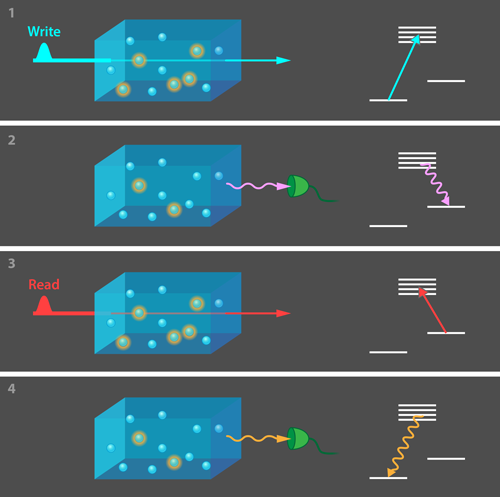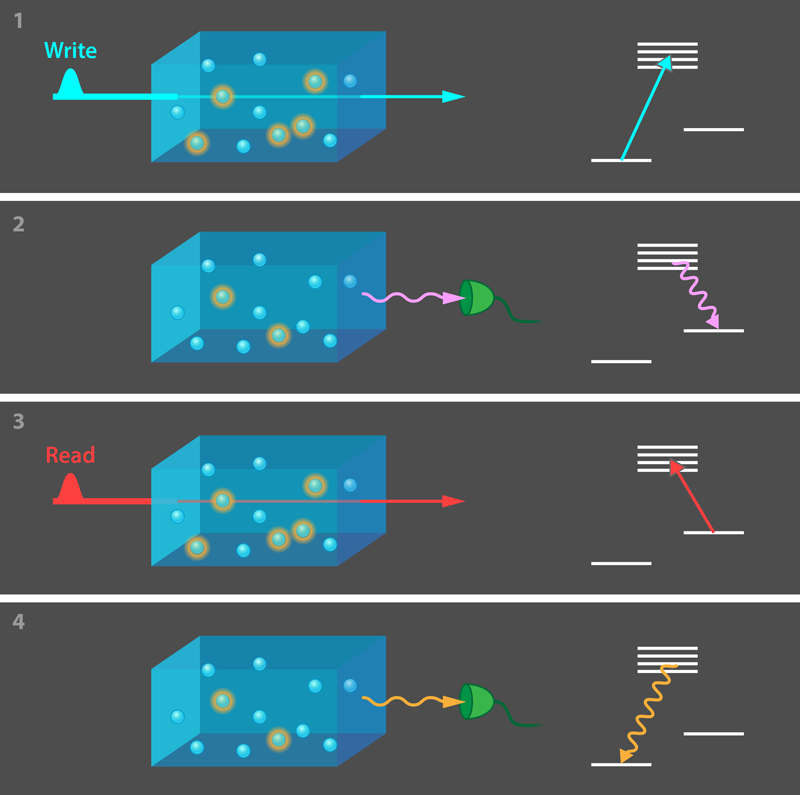A Solid Footing for a Quantum Repeater
Quantum secure communication relies on sharing of entangled states between parties. Over short distances (less than 100 km), these states can be distributed by sending photons over optical fibers, but losses in those fibers limit long-distance sharing. One solution is to use a sequence of “quantum repeaters” along the optical fiber connection [1]. These devices can store the quantum information in an excited state of matter. The states of two relatively close repeaters can be entangled through photon emission. This process can conceivably be repeated over and over to entangle more distant repeaters together, until the entanglement extends from one continent to another. Previous work on repeaters has focused on trapped gases [2, 3], but solid-state solutions would be easier to incorporate into existing optical networks. Three new experiments demonstrate the feasibility of using crystals doped with rare-earth ions [4–6]. They each show quantum correlations between photons and collective excitations of ionic dopants inside a crystal. This is an important step in developing solid-state quantum repeaters for a global network of quantum communication.
Entanglement is the key element that allows quantum cryptography to foil hacking attempts by eavesdroppers. That’s because any measurement of a quantum signal will degrade the quantum correlations between entangled states, setting off alarms of a security breach. However, the fragility of entangled states makes it impossible to distribute entanglement over distances of thousands of kilometers using current fiber networks. In 2001, researchers first proposed breaking the problem up into shorter segments [1]. The so-called DLCZ protocol (named after the authors Lu-Ming Duan, Mikhail Lukin, Ignacio Cirac and Peter Zoller) involves the creation of entanglement between quantum repeaters situated every hundred kilometers or so along an optical fiber link. These repeaters are first excited by a strong laser pulse. By interfering single photons emitted by two nearby repeaters, it’s possible to entangle their excited states. However, this interference is not always successful and can require several tries. For this reason, repeaters must be able to store the quantum information from the initial pulse for an extended period of time.
The DLCZ protocol has mostly been demonstrated in laser-cooled clouds of trapped alkali atoms, such as sodium or rubidium [2, 3], which have very strong optical transitions (as is evident from the bright orange glow of sodium street lights). But back in 2009, Mikael Afzelius, working with Hugues de Riedmatten and Nicolas Gisin at the University of Geneva in Switzerland, proposed a way to store light using the weak but narrow optical transitions of rare-earth ions, such as erbium and praseodymium, doped into solids [7]. In three new papers—one from the same Geneva group [4] and two from the Institute of Photonic Sciences (ICFO) in Barcelona, where de Riedmatten’s group is now based [5, 6]—the proposal has been put to the test.
Rare-earth ions have the unusual property of their unfilled electronic orbitals lying inside their filled shells, which provide shielding against the strong electric fields of the host atoms of the crystal where they are embedded. The ions’ optical transitions are thus narrow, like those of free atoms in a gas. However, the residual interaction with the solid host shifts the transition frequencies differently for each ion, so that the combined spectrum appears broadened. In addition, the optical transitions are normally forbidden, but they become allowed due to the host’s perturbation. This means the transitions will be weak, and as a consequence, the incoming light must be tuned close to the resonance frequency to increase the probability of absorption (and therefore storage). However, on-resonance excitation combined with the strong inhomogeneous broadening will cause the resulting atomic excitations to rapidly get out of sync. This dephasing would mean the stored information in the putative repeater would be lost.
The trick for overcoming the dephasing, as described in the initial proposal [7], is to shape the spectrum of the ions into an atomic frequency comb (AFC). In this method, a laser “switches off” those dopant ions whose transition frequencies correspond to the spaces between the teeth in the comb. If the remaining ions, with transitions spaced apart in frequency by 𝛿, are resonantly excited with another light pulse, they will rapidly dephase. But thanks to beating between the different frequencies, the ions will return in sync after a time delay of 𝜏=2𝜋∕𝛿. Not only does this “AFC echo” offer a way to retrieve stored quantum correlations generated by resonant excitation—circumventing the problem of weak transitions—but it also offers an advantage over the ordinary DLCZ protocol in having multiple temporal modes that can independently store quantum states. To understand this, imagine that a pulse excites the ions at time T, and then a short time later another pulse excites them at time T+ΔT, where ΔT<𝜏. The ions record both pulses as separate modes, each having its own corresponding echo, when the stored information can be recovered. The experiments [4, 5] demonstrate that a dozen temporal modes can be packed in a single doped crystal.
For their system, the Geneva group used europium as a dopant in an yttrium orthosilicate ( Y2SiO5) crystalline host. The ICFO team used the same host, but their dopant was praseodymium. In both cases, after optical pumping to produce an AFC spectrum, the teams excited their ions with a “write” pulse (see Fig. 1). The excited ion states emitted photons, which in a quantum repeater network would be used to entangle the emitting crystal with another crystal. However, in these simple demonstrations, it was enough to show that the emitted photons were quantum correlated with the excited ions in the crystal. For that, the teams used a “read” pulse to re-excite the ions. The researchers then measured the conditional probability that a single photon was detected following the write pulse and following the read pulse. They found that this two-photon coincidence was much higher than could be explained by any classical process, which implied that the emission was correlated to the quantum state of the ions.
In Refs. [4] and [5], the emitted photons are in visible wavelengths. However, in Ref. [6], the outgoing photon is generated differently. In this case, the ICFO team initially generated an entangled pair of photons—one at visible wavelengths and the other in an infrared band used in optical fiber telecommunications. The researchers utilized the visible photon to excite their doped crystal, which meant the infrared photon became correlated with the ion excitation, just as the emitted photons were in Refs. [4] and [5]. This demonstrates the feasibility of using the scheme at wavelengths compatible with existing optical fiber networks.
The results reported in these three papers represent the culmination of nearly a decade of work by these teams and others in the community. Along the way, the researchers have contributed improvements to optical pumping, polarization encoding, coherent control, and enhanced optical efficiency.
While the papers highlighted here mark an important milestone, there remains significant work to do in reducing the noise and optical losses, increasing the storage lifetime, and then demonstrating a prototype quantum repeater node. And at the same time, alternative technologies are making headway. Cold atom systems have already reached the prototype stage [8], and some groups are developing warm vapor DLCZ memories that do not require atom trapping [9]. In addition, researchers are now developing stoichiometric rare-earth crystals, where the ions form part of the chemical structure of the host, which eliminates inhomogeneous broadening and boosts the rare-earth density, providing a solution to the problem of weak transitions and broadened spectra [10]. Still, the groundwork laid by the Geneva and ICFO teams shows crystals doped with rare-earth ions remain a promising architecture for tomorrow’s quantum secure World Wide Web.
This research is published in Physical Review Letters and Physical Review X.
References
- L.-M. Duan, M. D. Lukin, J. I. Cirac, and P. Zoller, “Long-Distance Quantum Communication with Atomic Ensembles and Linear Optics,” Nature 414, 413 (2001).
- C. Liu, Z. Dutton, C. H. Behroozi, and L. Vestergaard Hau, “Observation of Coherent Optical Information Storage in an Atomic Medium Using Halted Light Pulses,” Nature 409, 490 (2001).
- S.-J. Yang, X.-J. Wang, X.-H. Bao, and J.-W. Pan, “An Efficient Quantum Light–Matter Interface with Sub-Second Lifetime,” Nat. Photon. 10, 381 (2016).
- C. Laplane, P. Jobez, J. Etesse, N. Gisin, and M. Afzelius, “Multimode and Long-Lived Quantum Correlations Between Photons and Spins in a Crystal,” Phys. Rev. Lett. 118, 210501 (2017).
- K. Kutluer, M. Mazzera, and H. de Riedmatten, “Solid State Source of Nonclassical Photon Pairs with Embedded Multimode Quantum Memory,” Phys. Rev. Lett. 118, 210502 (2017).
- A. Seri, A. Lenhard, D. Rieländer, M. Gündoğan, P. M. Ledingham, M. Mazzera, and H. de Riedmatten, “Quantum Correlations Between Single Telecom Photons And A Multimode On-Demand Solid State Quantum Memory,” Phys. Rev. X 7, 021028 (2017).
- M. Afzelius, C. Simon, H. de Riedmatten, and N. Gisin, “Multimode Quantum Memory Based on Atomic Frequency Combs,” Phys. Rev. A 79, 052329 (2009).
- Z. S. Yuan, Y.-A. Chen, B. Zhao, S.Chen, J. Schmiedmayer, and J.-W. Pan, “Experimental Demonstration of a BDCZ Quantum Repeater Node,” Nature 454, 1098 (2008).
- J.-P. Dou et al., “A Broadband DLCZ Quantum Memory in Room-Temperature Atoms,” arXiv:1704.06309.
- R. L. Ahlefeldt, M. R. Hush, and M. J. Sellars, “Ultranarrow Optical Inhomogeneous Linewidth in a Stoichiometric Rare-Earth Crystal,” Phys. Rev. Lett. 117, 250504 (2016).





